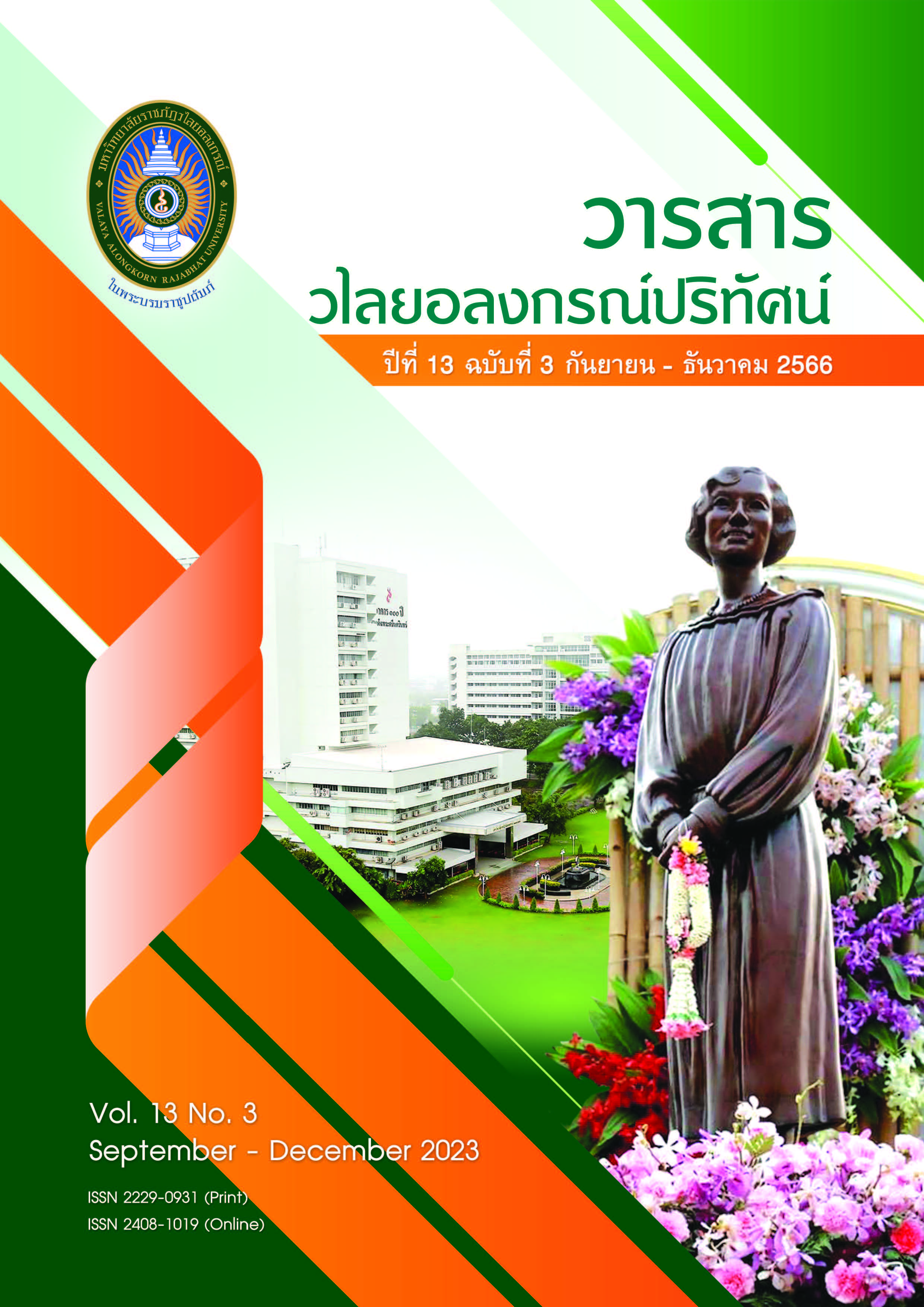ปัจจัยการจัดการการท่องเที่ยวเชิงบูรณาการภายใต้แนวคิด โมเดลเศรษฐกิจบีซีจี ที่ส่งผลต่อการตัดสินใจของนักท่องเที่ยว ตามแบบวิถีชุมชน ในจังหวัดเชียงราย
คำสำคัญ:
การจัดการการท่องเที่ยว, แนวคิดโมเดลเศรษฐกิจบีซีจี, การตัดสินใจของนักท่องเที่ยวบทคัดย่อ
งานวิจัยนี้มีวัตถุประสงค์เพื่อ 1) ศึกษาปัจจัยการจัดการการท่องเที่ยวเชิงบูรณาการภายใต้แนวคิดโมเดลเศรษฐกิจบีซีจี (BCG) และ 2) ศึกษาการตัดสินใจการท่องเที่ยวของนักท่องเที่ยวตามแบบวิถีชุมชนในจังหวัดเชียงราย โดยใช้แบบสอบถามเป็นเครื่องมือในการวิจัย กลุ่มตัวอย่างที่ใช้ ในการศึกษาคือ นักท่องเที่ยวที่นิยมเที่ยวตามแบบวิถีชุมชนท้องถิ่นในจังหวัดเชียงรายในช่วงเดือนตุลาคม-ธันวาคม 2565 จำนวน 100 คน ใช้การวิเคราะห์ข้อมูลด้วยรูปสมการถดถอยเชิงเส้น (Liner Regression Analysis) และการวิเคราะห์ถดถอยพหุคูณแบบขั้นตอน (Stepwise Multiple Regression Analysis)
ผลการศึกษาพบว่า ปัจจัยการจัดการการท่องเที่ยวเชิงบูรณาการภายใต้แนวคิดเศรษฐกิจ บีซีจี ที่ส่งผลต่อการตัดสินใจของนักท่องเที่ยวตามแบบวิถีชุมชนในจังหวัดเชียงราย พบว่า โดยภาพรวมอยู่ในระดับปานกลาง (M = 3.37) และหากพิจารณาเป็นรายด้าน ลำดับแรก คือด้านเศรษฐกิจชีวภาพ ในการนำองค์ความรู้ทางวิทยาศาสตร์มาพัฒนาแหล่งท่องเที่ยวอยู่ในระดับปานกลาง รองลงมาคือ ด้านเศรษฐกิจสีเขียว โดยการพัฒนาแหล่งท่องเที่ยวคู่กับการอนุรักษ์สิ่งแวดล้อม และลำดับสุดท้ายคือ ด้านเศรษฐกิจหมุนเวียน ในการนำวัตถุดิบเหลือใช้มาหมุนเวียนสร้างมูลค่าเพิ่ม มีค่าเฉลี่ยอยู่ระดับ ปานกลาง และการตัดสินใจของนักท่องเที่ยวตามแบบวิถีชุมชนท้องถิ่นในจังหวัดเชียงราย โดยภาพรวมอยู่ในระดับมาก (M = 3.45) และหากพิจารณาเป็นรายด้าน ลำดับแรก คือ ด้านราคาอยู่ในระดับมากรองลงมา คือด้านการส่งเสริมทางการตลาด ด้านช่องทางการจัดจำหน่าย และลำดับสุดท้ายคือ ด้านผลิตภัณฑ์มีค่าเฉลี่ยอยู่ระดับปานกลาง ตามลำดับ โดยมีนัยสำคัญทางสถิติที่ระดับ 0.01
เอกสารอ้างอิง
กัลยา วานิชย์บัญชา. (2560). การวิเคราะห์สถิติชั้นสูงด้วย SPSS for Window. (พิมพ์ครั้งที่ 12). กรุงเทพฯ: ห้างหุ้นส่วนจำกัด สามลดา.
ชิตวรา บรรจงปรุ สุวรรณา เตชะธีระปรีดา และสวียา ปรารถนาดี ชาติวิวัฒนาการ. (2565). รูปแบบความสัมพันธ์เชิงสาเหตุระหว่างความเป็นผู้ประกอบการเพื่อสังคม กลยุทธ์การตลาดสีเขียวที่ส่งผลต่อการดำเนินงานที่ยั่งยืนของวิสาหกิจเพื่อสังคมในประเทศไทย. วารสารชุมชนวิจัยมหาวิทยาลัยราชภัฏนครราชสีมา. 16(4), 164-175.
ฐิติ ฐิติจำเริญพร และดวงพร อ่อนหวาน. (2561). รายงานวิจัยโครงการวิจัยย่อยที่ 2 “แนวทางการพัฒนาการตลาดการท่องเที่ยววิถีชุมชนในรูปแบบเชิงพาณิชย์” ภายใต้ชุดแผนงานวิจัย การสร้างมูลค่าเพิ่มให้กับระบบเศรษฐกิจชุมชนฐานรากของจังหวัดเชียงใหม่ บนพื้นฐานการท่องเที่ยววิถีชุมชน. กรุงเทพฯ: สำนักงานคณะกรรมการการวิจัยแห่งชาติ (วช.) และสำนักงานกองทุนสนับสนุนการวิจัย (สกว.).
ดารณี อาจหาญ และเกิดศิริ เจริญวิศาล. (2565). การพัฒนาการท่องเที่ยวเชิงอาหารภายใต้แนวคิดเศรษฐกิจ BCG. วารสารวไลยอลงกรณ์ปริทัศน์ (มนุษยศาสตร์และสังคมศาสตร์). 12(2), 276-291.
ประชาคมวิจัยด้านเศรษฐกิจชีวภาพ เศรษฐกิจหมุนเวียนและเศรษฐกิจสีเขียว. (2561). สมุดปกชาว BCG in Action การพัฒนาวิทยาศาสตร์ เทคโนโลยีและนวัตกรรมของประเทศไทย เพื่อเศรษฐกิจชีวภาพ เศรษฐกิจหมุนเวียนและเศรษฐกิจสีเขียว. [ออนไลน์], เข้าถึงได้จาก file:///C:/Users/User/Downloads/BCG_WhitePaper 201811051.pdf. (2564, 20 เมษายน).
พรพจน์ ศรีดัน. (2564). รายงานฉบับสมบูรณ์ โครงการนวัตกรรมทางสังคมกลุ่มวิสาหกิจชุมชนเพื่อการพัฒนาผลิตภัณฑ์สู่การแข่งขันเชิงพาณิชย์ภายใต้ แนวคิดเศรษฐกิจหมุนเวียน (Circular Economy). กรุงเทพฯ: สถาบันวิจัยสังคม จุฬาลงกรณ์มหาวิทยาลัย.
มาโนชย์ นวลสระ น้ำเพชร เตปินสาย และชัชชญา ชุติณัฐภูวดล. (2564). แนวทางการพัฒนาผลิตภัณฑ์และตราสินค้าหนึ่งตำบลหนึ่งผลิตภัณฑ์ให้ได้มาตรฐานระดับสากล จังหวัดเชียงราย. วารสารวิทยาลัยดุสิตธานี. 15(1): 119-134.
ระบบสารสนเทศวิสาหกิจชุมชน กองส่งเสริมวิสาหกิจชุมชน กรมส่งเสริมการเกษตร. (2565). รายชื่อวิสาหกิจชุมชน/เครือข่ายวิสาหกิจชุมชน. [ออนไลน์], เข้าถึงได้จาก https://smce.doae.go.th/ProductCategory/SmceCategory.php?region_id=&province_id=57&hur_id=&key_word. (2565, 23 ธันวาคม).
วุฒิชาติ สุนทรสมัย. (2565). โมเดลความสัมพันธ์เชิงสาเหตุของภาพลักษณ์และกลยุทธ์การตลาดของแหล่งท่องเที่ยวเชิงสุขภาพที่มีอิทธิพลต่อความตั้งใจกลับมาเที่ยวซ้ำของนักท่องเที่ยวในจังหวัดปราจีนบุรี. วารสารชุมชนวิจัย มหาวิทยาลัยราชภัฏนครราชสีมา. 16(1), 37-50.
ศศิชา หมดมลทิล. (2565). ท่องเที่ยววิถีชุมชนวิถีสู่ความยั่งยืน. หน่วยวิเคราะห์เศรษฐกิจฐานราก ส่วนเศรษฐกิจฐานราก ศูนย์วิจัยธนาคารออมสิน. [ออนไลน์], เข้าถึงได้จาก: https://www.gsbresearch.or.th/wp-content/uploads/2019/10/GR_report _travel_detail.pdf. (2566, 30 สิงหาคม).
สำนักงานพัฒนาวิทยาศาสตร์และเทคโนโลยีแห่งชาติ (สวทช.). (2563). BCG Economy Model. [ออนไลน์], เข้าถึงได้จาก https://www.nstda.or.th/home/knowledge_post/what-is-bcg-economy-model/. (2565, 30 ธันวาคม).
Best, J., & Kahn, J. V. (1993). Research in Education. (7th ed). Boston: Allyn and Bacon.
Cronbach, L. J. (1990). Essentials of Psychological Testing. (5thed). New York: Harper Collins Publishers.
Hair, J. F., Tatham, R. L., Anderson, R. E., & Black, W. (2010). Multivariate data analysis. (5th ed.). New Jersey: Prentice Hall.
Likert, R. (2017). The method of constructing an attitude scale. In Scaling (pp. 233-242). Routledge.
ดาวน์โหลด
เผยแพร่แล้ว
รูปแบบการอ้างอิง
ฉบับ
ประเภทบทความ
สัญญาอนุญาต
ลิขสิทธิ์ (c) 2023 อัญยาณีย์ เกตุพันธุ์, ศศิวิมล ภู่พวง, สุทธดา ขัตติยะ

อนุญาตภายใต้เงื่อนไข Creative Commons Attribution-NonCommercial-NoDerivatives 4.0 International License.
ข้อความที่ปรากฏในบทความแต่ละเรื่องในวารสารวไลยอลงกรณ์ปริทัศน์ เป็นความคิดเห็นของผู้นิพนธ์แต่ละท่าน มิใช่เป็นทัศนะและมิใช่ความรับผิดชอบของกองบรรณาธิการจัดทำวารสาร และ
มหาวิทยาลัยราชภัฏวไลยอลงกรณ์ ในพระบรมราชูปถัมภ์


